Everything You Need to Know About Tandem Skydiving

If you'd like to experience an unusual and extreme activity in complete safety, try tandem skydiving! This activity might seem scary at first sight but the more you read on the more you'll realise how well it is supervised. Find out everything you need to know before booking your first jump thanks to this guide.
Do you dream of feeling the wind beat down on your face at over 220km/h? Having a truly sensational experience? Getting a big dose of adrenalin without needing to master skydiving techniques or undergo lengthy training?
Here, we talk freefall and explain how your first tandem skydive works. Unforgettable memories and thrills guaranteed. The only risk you'll face is becoming hooked. You'll be sure to want to do it all over again once you've landed!
Who can try tandem skydiving?
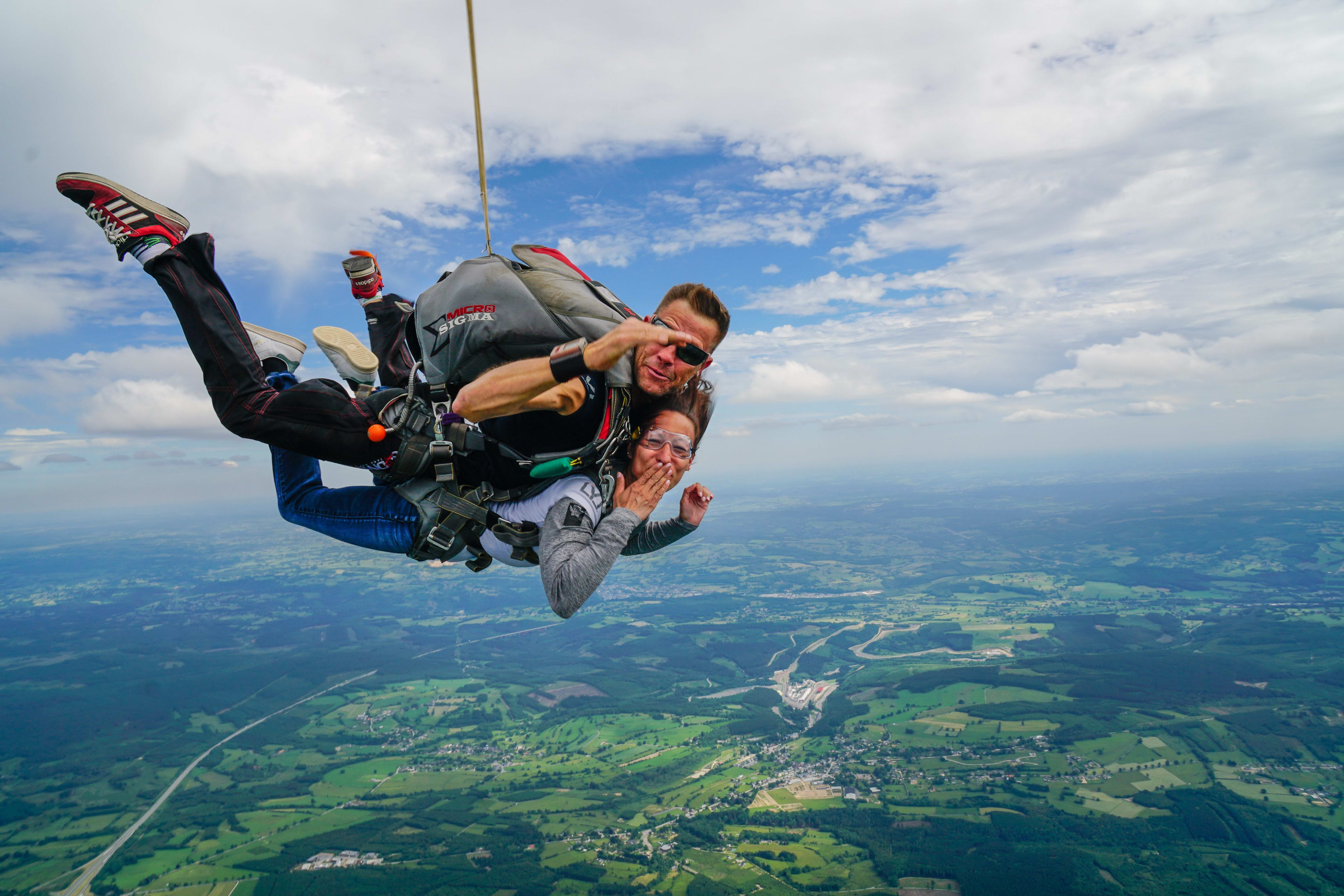
Tandem skydiving, as well as being a highly exhilarating sport, is also a very accessible sport, with only a few requirements:
Weight and age restrictions
Generally, the minimum age is 15 years old, but this may vary depending on the skydiving center that your jump is with. For example, in Belgium, they take the height of the jumper into account and not the age. However, minors in most countries will need to provide written parental consent to do a skydive jump.
In terms of weight, tandem skydiving is generally possible for everyone weighing less than 110kg. This, much like the minimum age, also varies depending on the center that you’re jumping with and how much your instructor weighs. If you weigh more than 100kg, it’s a good idea to contact the skydiving center before booking your skydive, to double-check that there won’t be any issues on the day of the activity.
Health and physical fitness
The only real health concerns that affect whether you can tandem skydive are heart problems and severe back problems. If you’ve fainted before, suffer from a heart murmur or have had a back operation you may want to speak to your doctor to make sure that you can skydive without risk.
Most skydive centers will ask for a medical certificate (from your GP) dated within the last 6 months, stating that you are allowed to skydive, without it causing any risks to your health. It’s also advised to be in good physical condition. You don’t necessarily need to be very sporty, but you must be in good health.
Can I skydive if I suffer from vertigo?
The short answer is: yes, absolutely!
Contrary to popular belief, vertigo is not a problem when skydiving. In fact, physically speaking, it's impossible to suffer from vertigo when skydiving. Vertigo is a state created when you're standing on the ground with the void around you.
In skydiving, you have no ground to stand on - you're flying. So even people suffering from dizziness when standing at the edge of a cliff or on a balcony won't experience vertigo during the free fall.
Is tandem skydiving dangerous?

Because tandem skydiving is so accessible, it's the safest and most popular way to take your first steps into the sky. When tandem skydiving, a total beginner can rely on the knowledge and experience of an experienced instructor during every stage of the jump. Tandem skydiving is a very safe activity that is always supervised by certified professionals. If you check the official statistics, you’ll see that skydiving is a lot safer than most people think. Not only that but it’s a lot safer than many other outdoor activities, like skiing for example.
Your instructor is sure to be an expert with many years of experience, as all tandem instructors need to have completed a certain amount of skydives (usually, the minimum is 1000 jumps!) before they are allowed to take the lengthy and strict tandem skydiving instructor course.
During this course they will have learnt to deal with numerous situations, all very complex, such as equipment malfunction, strong winds etc. These situations are very rare, however, it is important that your instructor is equipped to deal with them, should they arise. Note that your instructor will take care of all of the technical aspects during your tandem skydive, you don’t have to worry about a thing… Just sit back and enjoy this once-in-a-lifetime experience.
Where can I do my first tandem skydive?
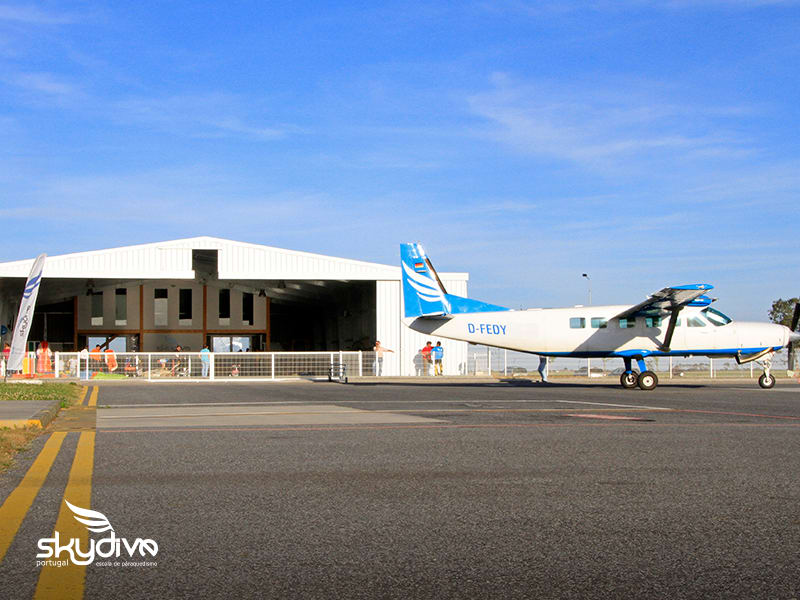
In a skydiving center of course! It is also known as a dropzone and you can find one pretty much anywhere in the world, though not all offer tandem skydiving. The most coveted ones are located near the sea or in the mountains, giving you the chance to take in some stunning landscapes and backdrops when you take that step into the void. There are around 400 skydiving centers in Europe and most dropzones are located outside big cities, as skydiving activities must not interfere with flights to and from large airports and their air traffic corridors.
Most dropzones are made up of a huge hangar where you can fold your canopies without any problems, and are linked to an airfield that has an administrative area where you can complete all the necessary paperwork and where jump sticks are planned (also called a manifest). There’s often a small refreshment area so spectators can relax comfortably whilst waiting for you to complete your jump. The landing area is typically made up of a large grassy area, which is often located in front of the hangar, giving you the perfect vantage point.
What to wear for a tandem skydive?
There are generally no specific clothing requirements, however, you are strongly advised to dress comfortably, keeping in mind the weather conditions. Jeans or trousers are probably your best bet. Don’t forget that once you reach an altitude of 3500/4000 metres, it’ll be 25 degrees cooler than when you were on the ground, so wearing a windbreaker or wool cardigan is a good idea.
That being said, you’re likely to be so hyped and full of adrenaline that you probably won’t even notice the cold.
Depending on the weather conditions, some skydiving centers can provide skydiving jumpsuits, but this really does depend on each center. The one thing all centers provide is goggles, enabling you to keep your eyes open during the skydive. Without goggles your eyes would tear up because of the wind generated during the freefall (over 200 km/h).
What happens if the parachute doesn’t open?
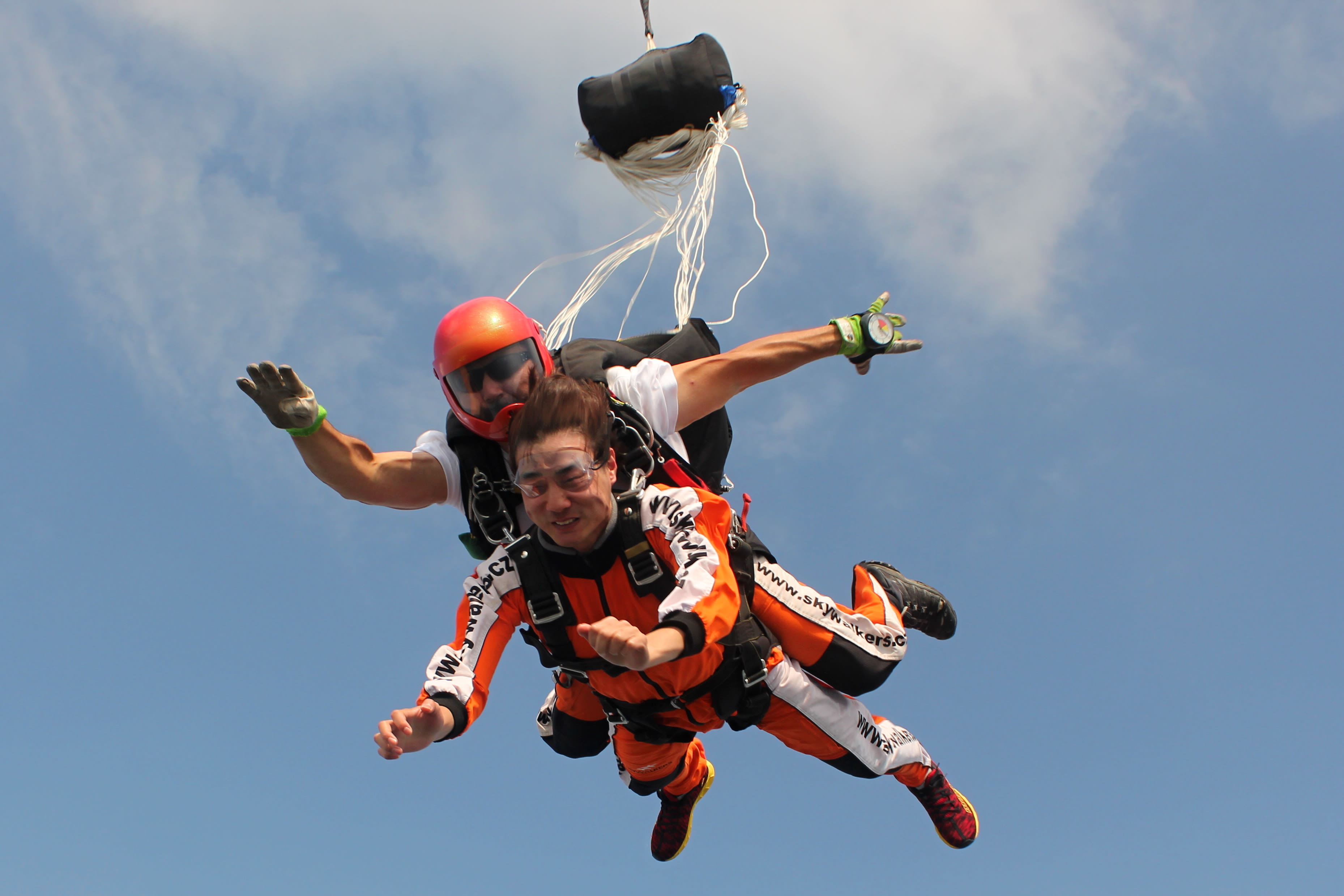
This is a recurring question, that often acts as a hindrance when people want to book a skydive. Before answering the question, let’s have a look at how a modern parachute works.
Forget the WWII films that always show a perfectly round parachute. Skydivers haven’t used a round parachute in over 35 years. The parachutes of today look more like paragliding canopies, more rectangular than round, and are linked to the harness via extremely resistant suspension cords. Actually and somewhat contra-intuitively, a modern parachute works a lot like an airplane wing. It generates lifts by moving horizontally, which basically means that a modern parachute can be maneuvered very precisely and helps you land very gently.
Each parachute system actually contains two parachutes!
This is part of the answer to your question! Each parachute, also known as a rig, is equipped with two complete parachutes. If the main one malfunctions then you have the backup parachute and it works exactly the same as the main parachute. The only difference between the two is that the reserve parachute was folded extremely carefully by a professional and certified “packer”. Reserve canopy packers use so much minitia, that the whole folding takes 5x longer than packing a main tandem canopy and usually costs north of US$150. That’s how serious packing reserve canopies is. So whatever happens in freefall, the backup parachute will always open.
What happens if the instructor is suddenly struck ill mid-flight (faints, heart attack etc.)? This is often the last question that first-time tandem skydivers ask. Who is going to open the parachute if the instructor is unconscious? This is an extremely rare scenario, but each modern parachute is mandatorily equipped with an Automatic Activation Device (ADD). This device automatically opens the reserve parachute at a preset altitude and speed. So in the worse scenario, the reserve parachute will open up itself.
Safety regulations for tandem passengers
There are only four security regulations for tandem skydivers to learn and follow during the jump. And you will be briefed thoroughly on these during your on-ground training session:
- Put your feet under the aircraft cabin when you’re sitting in the plane’s doorway once the door is open
- Put your arms over your harness (on your chest)
- Your head must be turned upwards when you jump
- And when landing, make sure your lift your legs, as your instructor will be hitting the ground first.
The rest is just pure enjoyment and awe, as the instructor will manage the freefall, the opening and the flying of the canopy.
Why is tandem skydive pricey?
A tandem skydive may seem expensive, but you must take into account:
- The cost of renting out the airplane that takes you up to the altitude you’re jumping from.
- The fuel – to reach said altitude you need to put enough fuel into the plane, which unfortunately does not come cheap.
- The price of the equipment you’ll be using – Tandem skydive gear costs around €13,000 brand new and requires a lot of maintenance to ensure safety regulations are continually met.
- The price of hiring a certified tandem skydiving instructor: most instructors are not employed directly by the skydiving center, but actually work on a freelance basis.
- The cost of ground training, setting up all the equipment on the ground, and coordinating the jump session. All dropzones need to not only have certified professional instructors, but also trained professionals on the ground to communicate with the plane and coordinate jump sessions.
- The license fee and compulsory insurance for both instructor and passenger.
All this combined explains why a tandem skydives costs what it does, and let’s be honest, it’s not all that expensive when you think of the incredible activity you’re going to experience. Let’s not forget that security does not come cheap (equipment, industry experts etc.) and that skydiving centers (thankfully) never skimp on security! Jumping from a moving airplane is no easy feat!
What are the types of planes used in tandem skydive ?
Only the best and most robust planes are used for skydiving. Indeed, on a typical Summer day, dropzones can organize more than 25 rotations at 4000m / 13500ft so only the most reliable and efficient planes are used. Most of the time, in Europe, you will be jumping from one of the following:
- Pilatus PC6-Porter with a 9-10 seater capacity
- Cessna Caravan and Grand Caravan with a 12-18 seater capacity
- Cessna 206 with a 6 seater capacity
All the aircrafts listed above are extremely efficient and reliable and have been tested and proven over decades, making them ideal for consecutive skydiving jumps. Noting that each rotation to 4000m takes 20-25 minutes on average, a day with 30 rotations means a LOT of time in the air and many jumps in a day!
Did you know that you can also do a skydive jump from a helicopter, in Interlaken, Switzerland, for example?
What happens on the day of your tandem skydive?
All the safety instructions for passengers will be communicated to you before your flight, but here's an overview of what to expect. They will be given to you by your instructor at the ground briefing:
When exiting the aircraft, you are asked to :
- Put your feet under the fuselage of the aircraft when you are seated at the aircraft door and it is open.
- Put your arms on your harness (at chest level)
- Raise your head upwards when jumping
1) The arrival at the dropzone and briefing
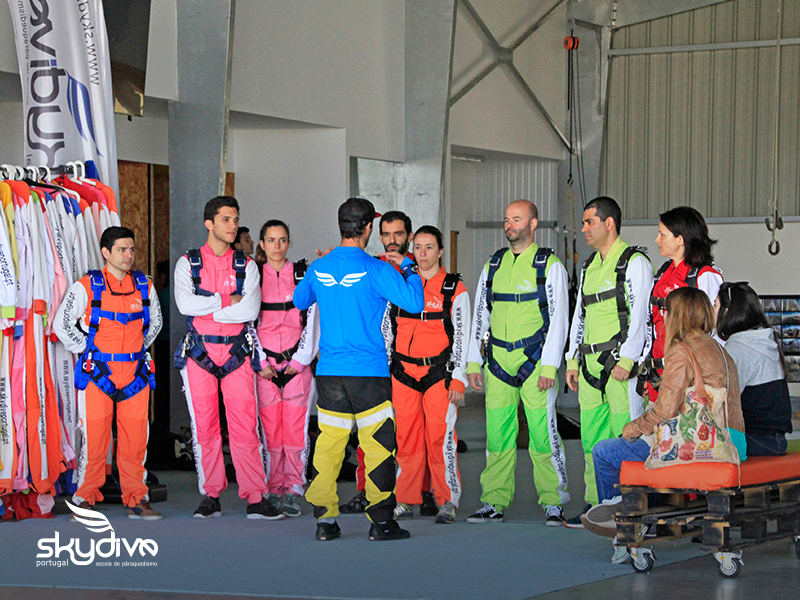
Once you arrive at the skydiving center, you will head to the administrative office where someone will help you take care of all the necessary paperwork (tandem license, insurance etc). After completing all the paperwork you’ll make your way to the hangar, where you’ll be introduced to your instructor or a ground training instructor. You’ll then have a short presentation of the activity, explaining and briefing the various stages and the four security regulations (explained above).
The presentation will last about 15 minutes. This is the ideal time to shake any fears you may have, by asking as many questions as you like. You’ll then be given your tandem harness, which is very simple looking and comfortable to wear. It’ll fit over your thighs, hips and shoulders. The harness will be connected to the parachute when you climb up to altitude in the plane.
Once all of the formalities have been dealt with, you’ll have to be patient as there’s often (not always) a bit of a waiting time, especially when you are scheduled to jump in the afternoon, or when the day’s jump session has been slowed by passing clouds.
2) The climb to altitude
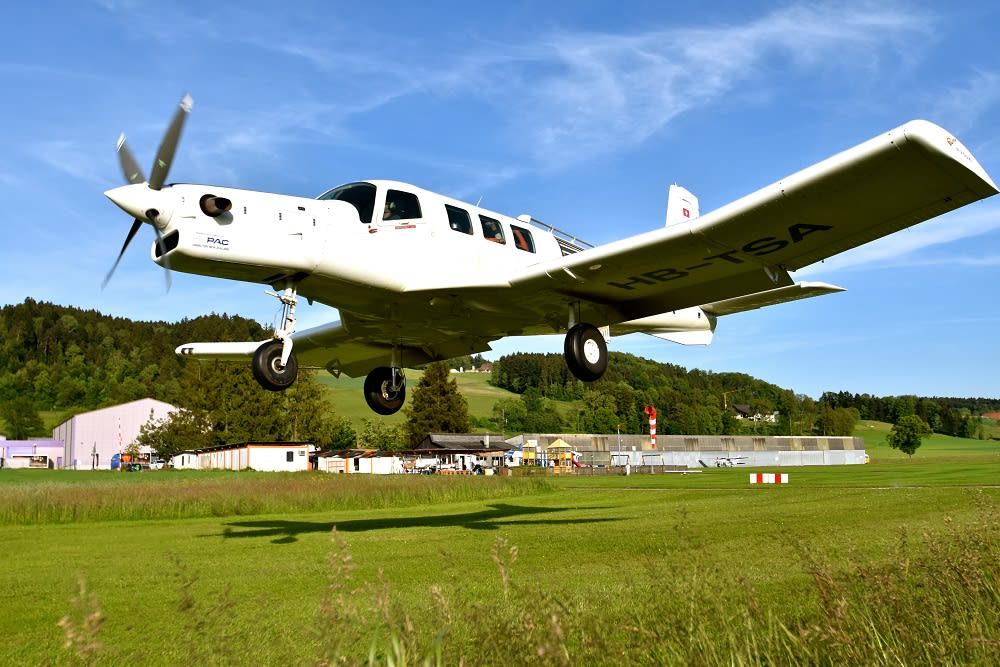
During your climb to altitude, your instructor will attach your tandem harness to the parachute using four hooks located at the shoulders and the hips. The skydive (usually) takes place at an altitude between 3000 and 4000 meters. All skydiving instructors wear an altimeter on their wrist, giving you a chance to see the increase in altitude as you climb up in the plane.
The flight up to altitude is often a combination of stress and pressure. Relax, take deep calming breaths and enjoy the stunning views. The flight is an integral part of the skydiving ritual, a moment of tranquility before the huge rush of adrenaline. This is probably the best time to ask them any questions you may have.
There may be other skydivers in the plane with you who are more experienced and passionate about skydiving and will be happy to share their experience and anecdotes with you. Not only that, but they know what it’s like to be a skydiving novice and will want you to enjoy your skydive as much as possible. And don’t worry if some take a nap in the plane, some skydivers do that!
Just before you arrive at jumping altitude, all skydivers in the plane start getting ready; carrying out their last security checks, putting on their helmets and goggles and setting their altimeters. Everyone wishes each other a happy skydive by high-fiving each other – a custom passed down from when skydiving, was in fact a somewhat dangerous activity. You too will be required to abide to this “have a good jump” ritual.
3) The jump
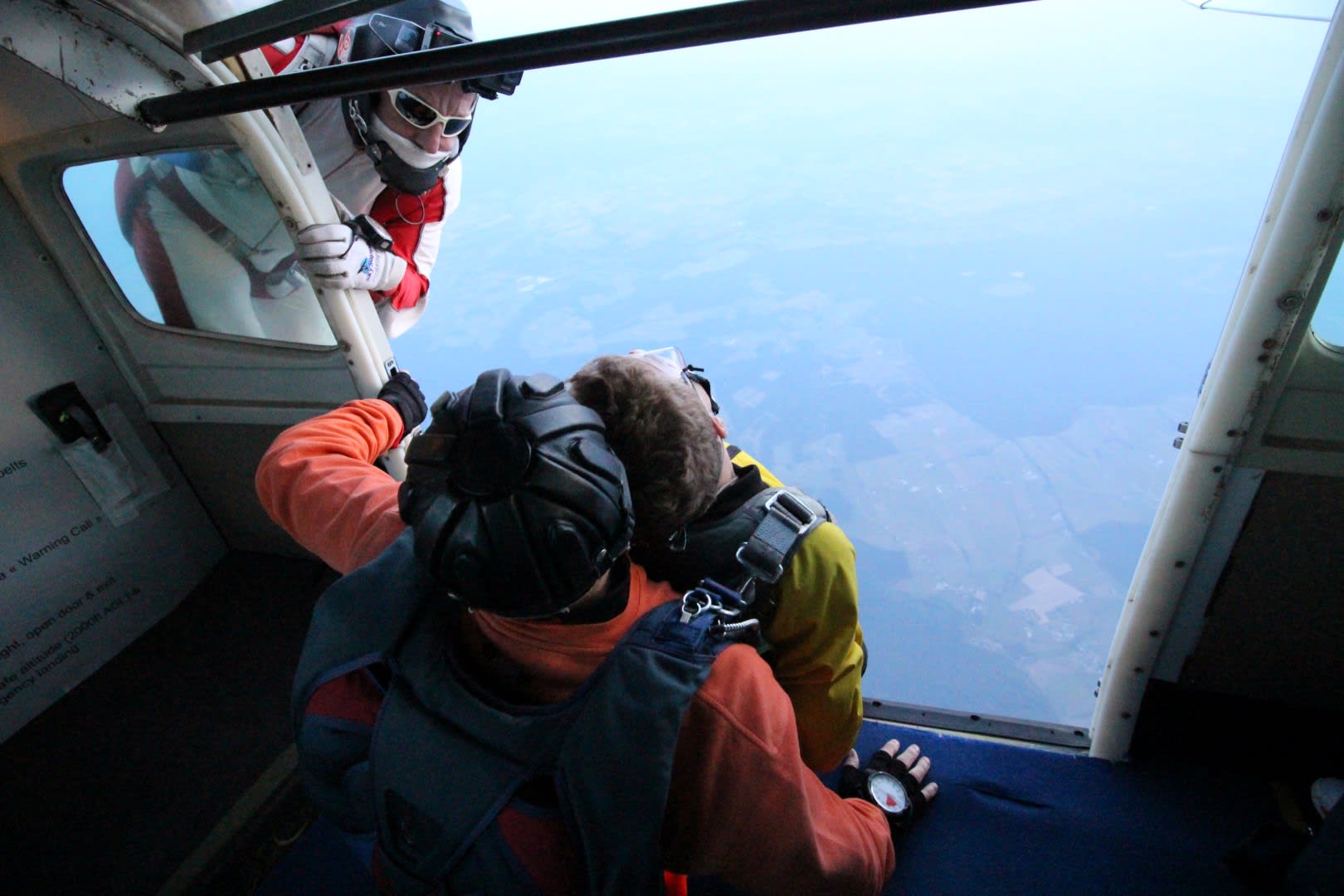
Once you’ve reached altitude, one of the instructors or experienced skydivers will open the plane’s door. All of a sudden you’ll notice a loud noise and wind will gush into the cabin of the aircraft, dropping the temperature (25 degrees less than what it was on the ground). This is when you’ll experience your first true rush of adrenaline!
If you’re not the first to jump (tandems tend to go last), you will have the chance to watch others jump before you – it really is a sight to behold! As the ceiling of the cabin is very low, you and your instructor will have to crawl to the plane’s door and hang your legs out of the doorway into the void! At this point you’ll put your arms on your harness, place your legs under the cabin (on the outside of the plane) and lift your head towards the sky, creating the aerodynamic freefalling position. If you have chosen the filmed/photographed option, then your photographer will jump a few seconds before you, but will hold onto the plane waiting for you to jump.
Your instructor will then move forward into the void. Very quickly, the wind created by the jump will carry you (very similar to when you put your hand out the window on a motorway). You’ll feel the force of the air under you like a cushion of air. Contrary to popular belief, at no point will you feel like you’re falling, at most a mild acceleration.
4) The freefall
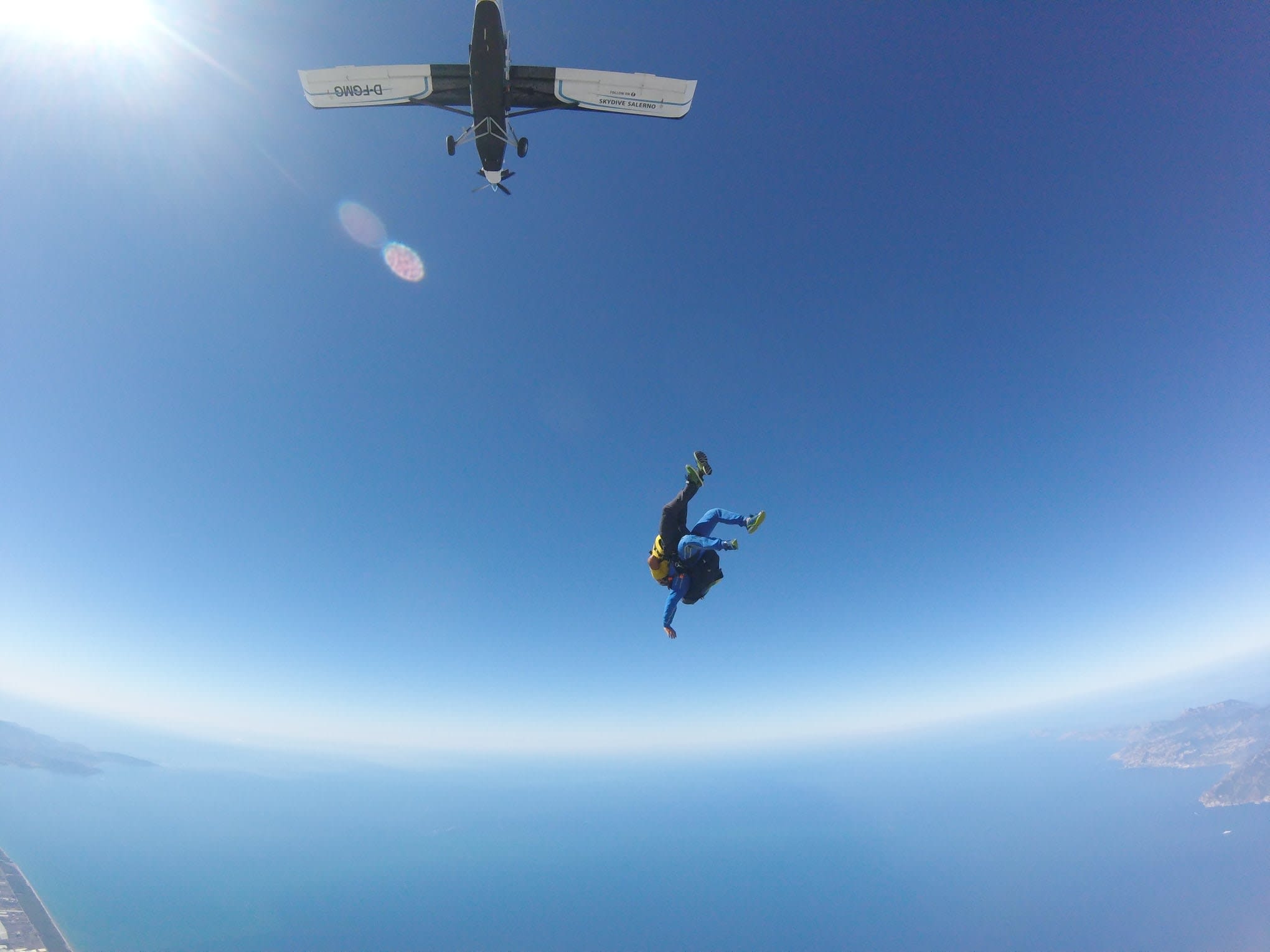
As you leave the horizontal speed provided by the plane and transition to vertical speed, your body positioning will become more and more parallel to the ground. The freefall lasts between thirty and fifty seconds and reaches speeds of up to 220 km/h in about 8 seconds.
Once you’re over the sense of exhilaration and surprise of “not falling but flying”, you will be able to enjoy the freefall. The wind, the speed, the view; everything goes by very quickly and if the wind wasn’t howling so loudly in your ears, it would be a very peaceful and comfortable descent.
5) Flying under the canopy
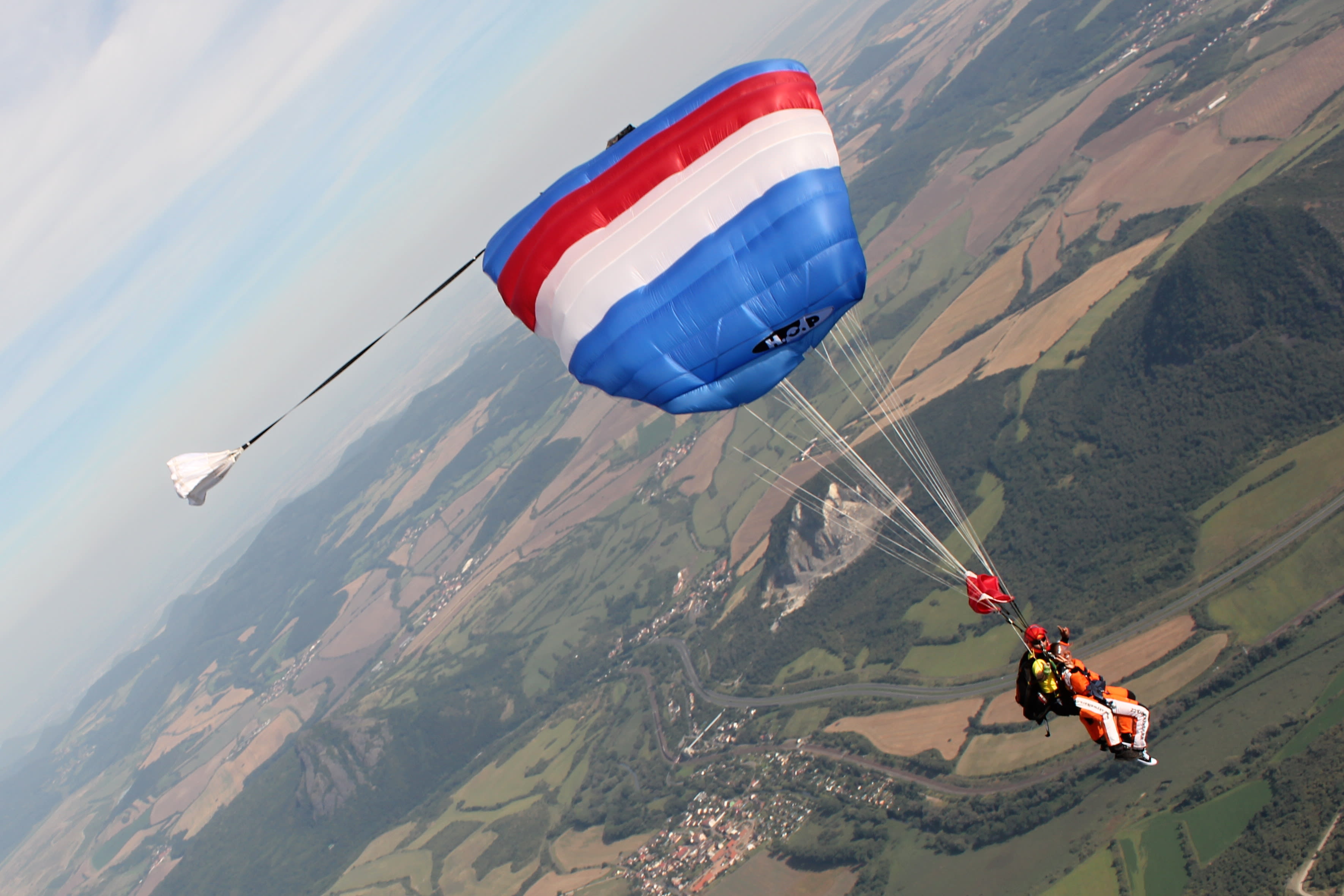
Having reached an altitude of 1500 meters / 4500 feet, your tandem skydiving instructor will start the process of opening the parachute. This is probably the hardest part physically, as slowing down is a little turbulent. You will go from 220 km/h to 10 km/h in just under 2 seconds. At 1300 meters the canopy will finally open up and you’ll suddenly experience a moment of tranquility. No noise, no wind, everything is quiet, calm and beautiful.
Gone is the pressure, gone is the stress. This is probably the point where you’ll experience your second rush of adrenaline. Your body will release dopamine, serotonin and endorphin once you fully realized that you’ve done it! You jumped from a moving plane and your parachute has opened without any problems! More often than not most skydivers (including experienced ones) can’t help but grin or shout! What will your reaction be?
You can actually speak to your instructor now, the wind is no longer an issue so feel free to chat away. Now that your parachute is open you’ll have 10 minutes to do a little aerobatics. Maybe you’d like to steer the parachute yourself or execute 360° turns? No problem! The parachute is equipped with a pair of secondary steering handles for you to play with the canopy, and your instructor will guide you if you want. You can enjoy exhilarating thrills like never before! Conversely, if you want to just sit back and take in the stunning panoramas around you, then your instructor will take care of flying the parachute. It’s fully optional.
6) Your landing

By now, the photographer will have already opened their parachute and landed, and would be waiting to film your landing and welcome you back to earth. After 10 minutes of flying under the canopy (this may vary depending on the wind conditions), your pilot will start the landing process. The landing normally takes place in the dropzone, in front of the hangar, giving your friends and family the chance to see your landing firsthand. Depending on the weather conditions your pilot may ask you to land standing up or sliding on your bum, whatever is the safest option on the day.
How will I be photographed or filmed on my tandem skydive?
Most, if not all dropzones, offer the possibility of filming or photographing your jump. Options generally vary depending on the skydiving center and the country in which you’ll be doing your tandem skydive, but overall there are two popular services offered:
Instructor with their own photography/filming equipment
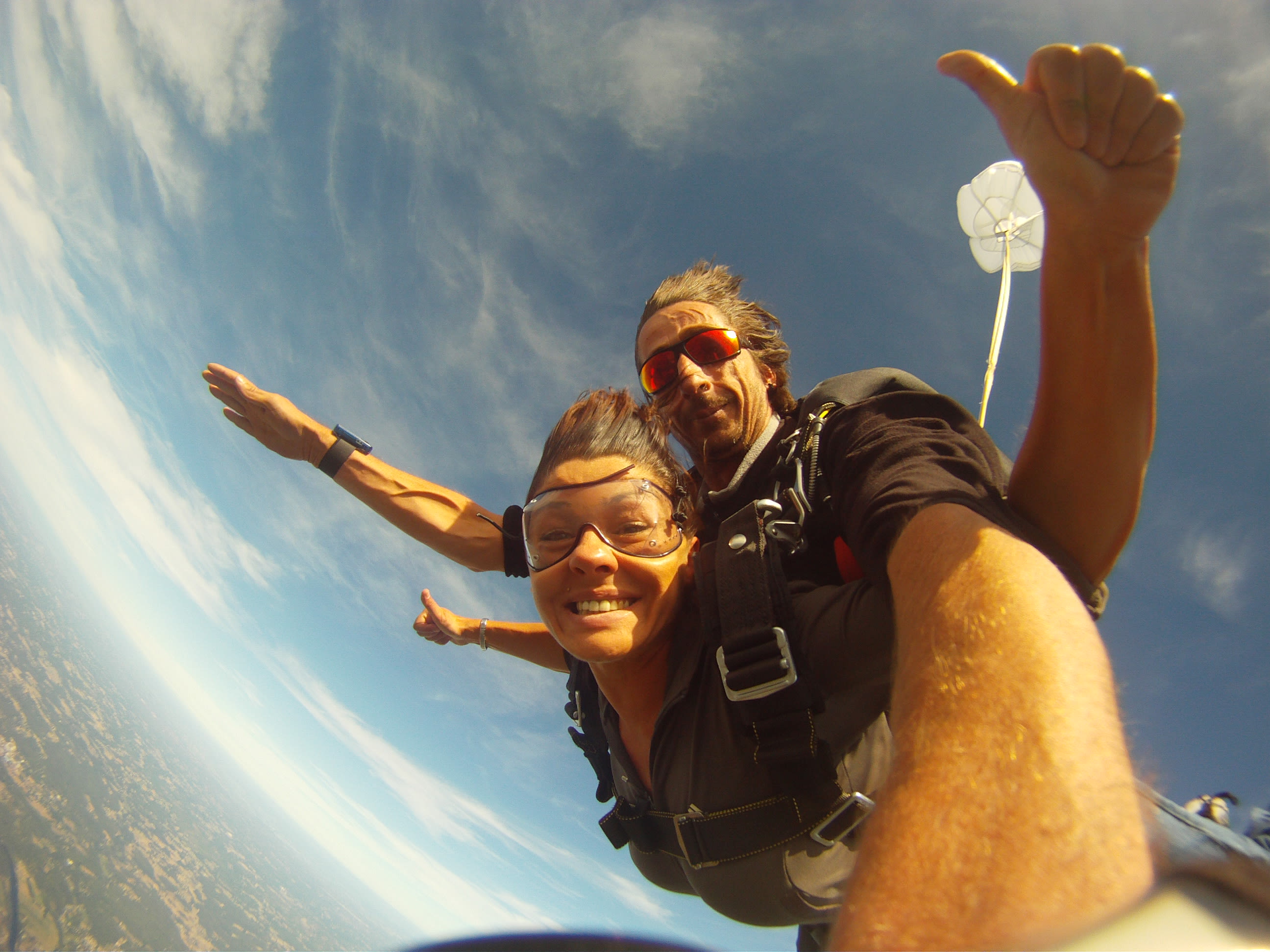
In some cases, your tandem skydiving instructor may wear a GoPro on their wrist to film your skydive. Although this option may be cheaper than the above, the drawback is that your instructor won’t be able to film you from the outside and the photos may not be as impressive. You will, however, have photos of you flying under the canopy (once the parachute has been opened).
Being filmed/photographed by a “videoman”, in addition to your instructors
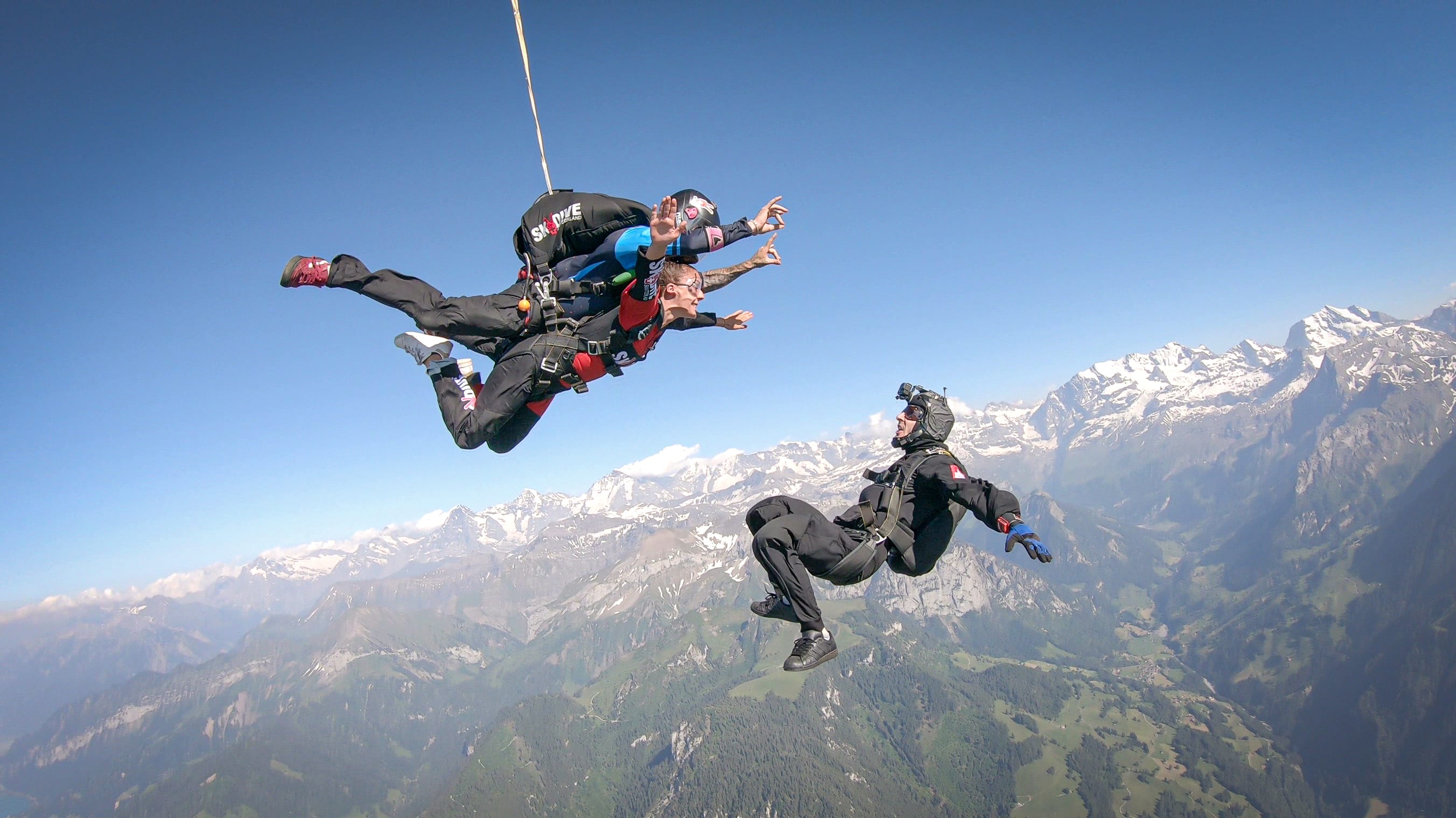
Videomans are expert skydivers who has been specifically trained to film skydivers as they freefall. They will jump alongside you from the plane and will film/photograph you from all angles to make sure you’re provided with the best pictures of your skydiving adventure.
Once your instructor opens the parachute, the cameraman will stop filming and prepare their own landing so they can arrive on the ground before you, giving them enough time to film your landing. This option is generally the most expensive, as you have to pay for the skydive of the photographer as well as the photos and video. However, the video and photos are guaranteed to be much better quality than any of the other options, and you get the added benefit of seeing another skydiver around you in the air whilst you freefall.
Both options guarantee you amazing photos and video that you can share with your family and friends. Make sure you immortalise your skydiving adventure – it would be such as shame not to film or photograph this exceptional moment.
Take off for new adventures...
If this article has aroused your curiosity on this subject, you can discover our list of the best skydiving films to marvel at the beautiful scenes of this extreme sport!
You are more into experiencing the adrenalin for real? Whether you're in Europe or the rest of the world, there are plenty of spots where you can take to the skies and skydive, whether you're jumping from a helicopter in Switzerland or taking a tandem skydive in Tahiti to enjoy a panoramic view of paradise! You'll be blown away by the beauty of the scenery: it's clearly a once-in-a-lifetime activity...